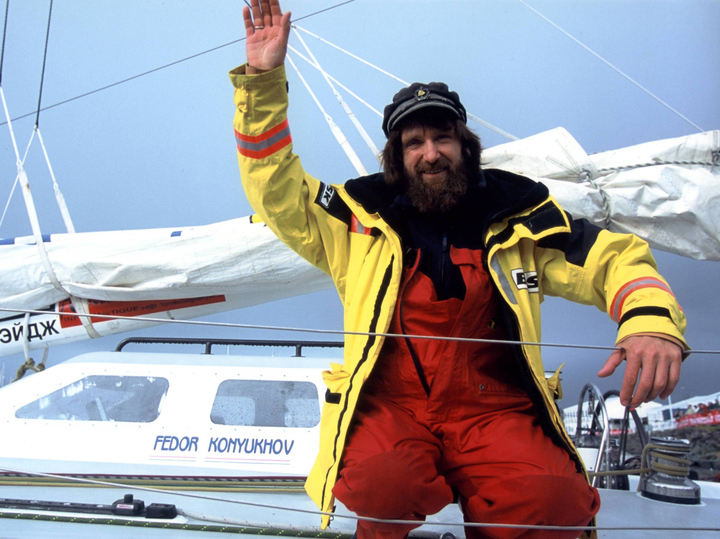Fedor Konyukhov was planning to cross two oceans using the energy of the Sun
[ad_1]
During his new journey, the famous extreme sports enthusiast will collect garbage floating in the water.
The famous traveler Fyodor Konyukhov proves that he is ready to persevere in his desire to carry out the miracle expedition he once planned. We are talking about the “water project” – a transoceanic raid carried out on a very unusual “ship of the future”.
Judging by the information that has appeared, the Russian extreme cannot be prevented from doing this even by the most serious problems that arose first in connection with the rampant pandemic, and then with the aggravation of the foreign policy situation.
The RIA Novosti agency reported that Konyukhov is going to make a solo crossing across the Pacific Ocean for the first time in history on a catamaran driven by solar energy: “I’m leaving for six months, I have a program – microplastics in the ocean. I’ll go on a catamaran, it will be solar-powered…”
These Konyukhov plans first became known several years ago. But on the way to their implementation, many obstacles arose, including on a global scale. However, Fyodor Filippovich still intends to implement this project of his.
According to the information posted on the traveler’s website, the very possibility of such an expedition became a reality, thanks to the domestic designer Mikhail Lifshits, who “developed methods for providing energy to sea and river vessels driven by energy from solar panels…”.
Fyodor Filippovich gave more detailed explanations to a MK correspondent some time ago:
– The future transoceanic crossing has two important goals. The first is to draw attention to the possibilities of alternative energy. If it is possible to cross the ocean using solar energy, then we simply must use it in everyday life. The second goal of the project, called NOVA, is to assess the actual level of pollution in the oceans. While sailing, I will watch the ocean and keep a video diary. The catamaran will be equipped with special flow-type filters capable of capturing the smallest particles of plastic found in ocean water. Every day I have to retrieve the “catch” caught by these filters, package and label such collected samples, indicating the coordinates of the place, the time of accumulation of each portion, as well as the readings of the meter that measures the amount of water that has passed through the filter. All materials will then be transferred to oceanologists for analysis. Such data will make it possible to build mathematical models and better study the paths of “garbage” flows in the ocean.

Since 2000, I have known Phil Morrison, the famous British boat designer and yachtsman, continues Konyukhov: “Phil designed three of my rowing boats, on which I previously successfully crossed the Atlantic, the Pacific Ocean from Chile to Australia, the South Pacific Ocean from New Zealand to Cape Horn. Phil has a very good sense of what exactly I need. So, when the idea arose to cross the ocean on a ship with solar panels, I decided not to take risks and not experiment with others, but asked for help in realizing the idea of such a “solar-powered” ship “to Phil.”
It was Morrison who suggested the catamaran option. It is more stable than a traditionally designed boat and has higher speed. In addition, the catamaran deck allows you to place more solar panels. According to the project, the area of such modules, horizontally located on the deck, is 51 square meters. This will make it possible to obtain a maximum of 9 kW of power to power electric motors and equipment available on the ship. In addition, additional batteries that “catch the sun” are also installed on the sides of the catamaran, thanks to which it will be possible to generate even more kilowatts. All photosensitive modules are designed and manufactured in Russia. The material for the catamaran hull is also a domestic development. It is a lightweight and durable carbon fiber composite.
As Fedor Konyukhov explained, in one of the hulls of the NOVA catamaran there is a navigation room, in the other there is a galley and a seawater desalinator. It was also necessary to place almost half a ton of batteries on board and at the same time ensure their reliable protection: after all, the aquatic environment around is dangerous for such elements.
The expedition route has already been worked out. It is divided into two stages. The Atlantic – from the Canary to the Caribbean Islands – with a length of 3,000 nautical miles, is expected, judging by the information on the traveler’s website, to be carried out this year. And the second stage, the Pacific, will take place in 2024. The traveler starts from the coast of Chile and finishes on the east coast of Australia. The distance of this journey is 9 thousand nautical miles.
– But how are you going to “teleport” your catamaran from the Caribbean to Chile?
– We foresaw a solution to this problem in advance, even at the design stage of the vessel. Its dimensions (40 feet long) and design are such that it can be disassembled, loaded into a standard sea container and delivered to anywhere on the planet.
[ad_2]
Source link








